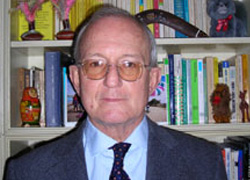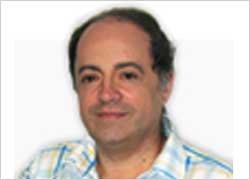IMDEA Networks

Event Category: External Presentation (IN Speaker)
Bounds on QoS-Constrained Energy Savings in Cellular Access Networks with Sleep Modes
Sleep modes are emerging as a promising technique for energy-efficient networking: by adequately putting to sleep and waking up network resources according to traffic demands, proportionality between energy consumption and network utilization can be approached, with important reductions in energy consumption. Previous studies have investigated and evaluated sleep modes for wireless access networks, computing variable percentages of energy savings.
Read more arrow_right_altShaping and designing cellular systems
The objective of this course is to learn how to model cellular systems for the use in optimizing the design of this type of network. The course will consist of the following parts:
- A revision of basic queueing models
- Analysis of cellular systems with a single cell
- Channel reservation strategies possibility for the design of systems that optimize performance whilst minimizing the probability of interrupting current sessions
- Models and algorithms to support the different priorities of existing users
- Flow guarantees to different users through models of service differentiation
- Hierarchical cellular structures
Endless Arguments in Systems Design, or, has the GENI lost its bottle?
In work at Washington St Louis and Stanford on network virtualization a lot of the research is predicated on lots of fancy hardware for forwarding (viz NetFPGA) (a recent SIGCOMM reject by UCL/Lancaster people on this got multiple GigEs at line rate fairly nicely - a good solid piece of work on mid-range affordable virtualized routers) – but that is virtualized _forwarding_ - the real control plane is the routing protocols- if you want to virtualize that, its because you want multiple co-existing routing computations (possibly for isolated VPNs, or possible for services for different users or for robustness to attack etc etc etc) so then what you want is META routing.
Read more arrow_right_altMobility – Background, State-of-the-art, Challenges and Approaches
Mobility is, without doubt, one of the major new paradigms of the current Internet, and this is driving most of the research activity in networking throughout the World. We are gradually evolving from a network where most end-systems have a fixed or quasi-fixed point of attachment, towards a global network where end systems seamlessly move from network to network and where networks themselves change their connection point to the Internet. In spite of this there is still a long way to go before user and network mobility – at IP level – become a reality, as several technological and research challenges persist.
Read more arrow_right_altThe GeoNet Final Workshop
The GeoNet consortium invites you to attend its final workshop as a unique opportunity to learn more about IPv6 geonetworking and the link between IPv6 geonetworking and the related ITS development in CAR 2 CAR Communication Consortium, CVIS implementation and ETSI TC ITS standardization. During the workshop you will get information through communications and posters and also see the system working in real cars. Please find the program in attachment with practical details (exact place, registration procedure...).
Read more arrow_right_altCAESAR: Carrier Sense-Based Ranging in Off-The-Shelf 802.11 Wireless LAN
802.11 wireless local area networks have been designed for wireless communication. The principle for 802.11 communication is that frames are acknowledged (ACKed) after a short and predefined MAC idle time. Despite the MAC idle time is designed to be constant, we find that it varies with i) the physical distance between stations, caused by the delay of wireless signal propagation, and ii) the time to detect the ACK at the local station, which varies with the signal strength of the incoming ACK. Exploiting this knowledge, we present CAESAR, CArriEr Sense-bAsed Ranging, that combines time-of-flight and signal-to-noise ratio measurements to calculate the distance between two stations. CAESAR measures the distance by estimating the MAC idle time in a data/ACK communication at a 44 MHz clock resolution and the ACK detection time on a per-frame basis. CAESAR is a software-based solution that is entirely implemented at the transmitter and it requires no 802.11 protocol modifications. We implement CAESAR on commodity hardware and conduct extensive experiments both in controlled network conditions and dynamic radio environments. Our measurements confirm the accuracy of the solution and show the capability to track the distance to WLAN smartphones at pedestrian speeds.
The work above has been conducted at Disney Research and published at ACM Conext'11.
The last part of the talk will briefly present ongoing research activities conducted at ETHZ in the area of time-of-flight WLAN localization.
Read more arrow_right_altCROWD Kick-off meeting
On Jan 8-9, 2013, the kick-off meeting of Research & Development project CROWD (Connectivity management for eneRgy Optimised Wireless Dense networks) was held in Pisa (Italy). CROWD is co-funded by the European Commission within the Seventh Framework Programme (FP7).
Read more arrow_right_altSome combinatorial results initiated by application areas
In this self-contained talk I will describe few combinatorial results that were initiated by problems from several application areas. These results include the following: (1) the use of the Cycle Lemma in deriving statistics about several classes of trees (this includes, as a start, a very simple proof for the Catalan number of binary trees), (2) a new characterization of tree medians, (3) an algorithm for generation of permutations, (4) a result about the volume of discrete spheres, and (5) a combinatorial problem that resulted in a paper with
Paul Erdős
Google+ or Google-? Dissecting the Evolution of the New OSN in its First Year
In the era when Facebook and Twitter dominate the market for social media, Google has introduced Google+ (G+) and reported a significant growth in its size while others called it a ghost town. This begs the question that "whether G+ can really attract a significant number of connected and active users despite the dominance of Facebook and Twitter?".
Read more arrow_right_altSynchronized Protocols: From Safe Cyber-Physical Systems to the Next ARPA-Net
We are entering an era where accurately synchronized clocks are economical and are becoming commonplace. Commercial GPS units synchronize clocks within 10’s of micro-‐seconds. Chip sets that implement the IEEE 1588 standard are synchronizing clocks within a fraction of a nano-‐second to improve the probability of collisions in particle colliders.
Read more arrow_right_alt











Recent Comments